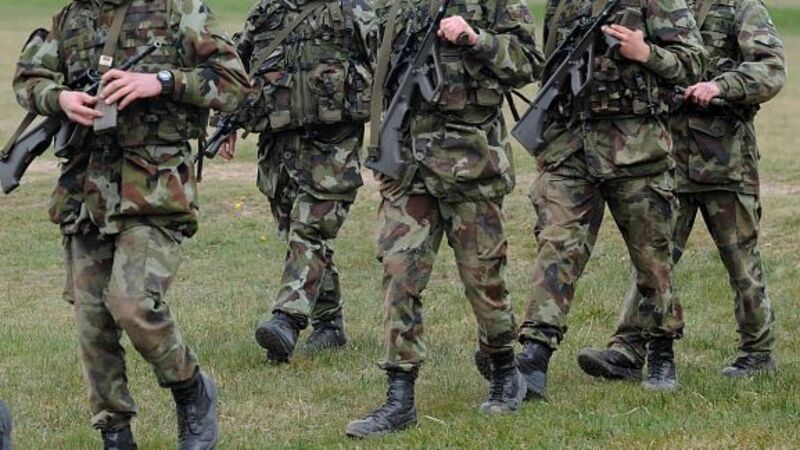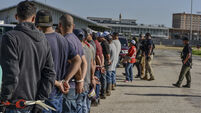Dear Sir... Readers' Views (07/10/16)

Number of Reserves in army too low
In 1916, a group of citizen volunteers fought for Irish freedom during the Easter Rising.
They were not professional soldiers. They were not paid for what they did. But their actions paved the way for the creation of the modern Irish Republic.
One hundred years on, the memory of those original citizen volunteers was honoured across the country earlier this year.
However, in 2016, the closest thing that the Irish Defence Forces’ currently has to those original volunteers — the volunteer soldiers and sailors of the Reserve Defence Forces (formerly An Fórsa Cosanta Áitiúil, or FCÁ) — are being widely mistreated and undervalued.
This undervaluing is arguably most apparent in the area of recruitment to the Reserve. The Reserve has an establishment of 4,069 personnel, yet its current strength is only 2,281, or 56% of what it should be.
This is not due to lack of interest — there are thousands of applications every year — but rather due to mishandling of the recruitment process by the Defence Forces. The strength of the Permanent Defence Force (PDF) is currently 9,025, or about 95% of its establishment of 9,500. To remedy this, the PDF is currently engaged in a massive — and effective — recruitment drive. Meanwhile, the Reserve is not being properly facilitated to fill the nearly 2,000 vacancies in the force, despite the continually high level of applications.
Firstly, when applying for the Reserve, applicants are faced with open-ended closing dates for each recruitment competition. For those who stick with the process, medical testing is the next hurdle. The Defence Forces has recently imposed a limit on the amount of recruitment medicals that it will deliver to Reserve applicants.
This means that an individual Reserve unit might have 100 willing and enthusiastic applicants, but they are told that only 20 can be medically tested, thereby preventing the other 80 from ever seeing a uniform. For those that are facilitated with medicals, these are often provided exclusively during normal working hours, despite the Defence Forces’ stated policy of being a 24/7 organisation.
And so the pool of applicants gets smaller.
Finally, Reserve applicants encounter the largest hurdle of them all. The Defence Forces’ processing of Garda Security Vetting and Garda Security Clearance applications for the Reserve is particularly poor. It can often take an incredible 18 months — or more — to security clear a Reserve applicant.
The mishandling of Reserve recruitment is shown in the figures. In 2016, despite having nearly 2,000 vacancies, the Reserve was only facilitated to induct 72 new members. Hundreds applied for places, but fell by the wayside during the various stages of the recruitment process.
Nowadays, most Reservists work alongside their PDF counterparts in multiple roles. Reservists are willing and enthusiastic citizen volunteers, and there are thousands who are looking to join every year, but who are prevented from doing so.
The Defence Forces could be improving their personal development; providing them with leadership, motivation, resilience, planning, organising, decision making and problem solving skills, along with training and recognised qualifications, but this is not happening. It is unacceptable to see the force be mishandled and undervalued as much as it is.
Neil Richardson (General Secretary) Reserve Defence Force Representative Association (RDFRA)
History of hunger strikes is important
An event took place in the YARD in Falcarragh, Co Donegal, on September 24, to commemorate the thirty-fifth anniversary of the deaths of the 10 young men in the 1981 hunger strikes.
This should provide an impetus to bring this part of our history to a much wider and younger audience.
One of the outcomes of the peace process is that our recent history is being exposed to an eager audience who are mesmerised that such wilful horror was allowed to unfold because one section of Northern Ireland’s society were denied their civil rights.
The same secrecy was applied in regards to the 1916 rising and its bloody aftermath in the years that followed. This remained hidden under a cloud of secrecy over the last 50 years. It is only now because of the commemorations surrounding the 100th anniversary of the Easter rising that atrocities committed during the civil war are slowly coming to the surface.
It is difficult for any journalist or columnist to write on these matters. Political correctness and the prevailing wind of opinion often prevents writers from saying how it is.
Writing about our history is very important and it recalls what was a dark and turbulent period of civil unrest in the six northern counties.
The inclusion of the 1980-’81 hunger-strikes in schools curriculum is to be commended. It is another step in uncovering the abuse, torture and degrading tactics used by the governing administration in Ulster that left the option of a ‘slow painful death’ as the only honorable route for 10 very brave young men in the hell hole of the H Blocks within the walls of the Maze prison.
An approach has been made to Pobal Scoil Cloich Ceann Faola in relation to holding such an informative event as a spring board in the education of students who may wish to study recent Irish History in more detail. Every secondary school in the country should avail of this opportunity while many who took part in these actions are still alive.
You can read all the literature you want on this subject, but nothing can replace the chance to interact on an intellectual basis with ex-hunger strikers in face to face meetings as part of this ‘Living History’ project.
While almost all the focus has been on men who died or took part in the hunger-strikes, very little has been voiced in a public capacity on the role of women who participated in hungerstrikes in Armagh Jail during this period. Theses women were also forcibly stripped by male prison staff, searched, and had their orifices probed irrespective of the timing of their menstrual cycles up to six times per week.
Three such prisoners Mairead Farrell, Mairead Nugent, and Mary Doyle survived; however Mairead Farrell was later murdered by the SAS.
The pain and suffering of all those involved, including their families is almost too horrific to write about.
it is important that we do our utmost to educate our young in relation to this part of our history, even the uncomfortable truth of what happened on all sides.
Those who knew the participants in the hunger-strikes, and were first hand witnesses to the reality of a “dirty war” in the six counties are best placed to do it.
Danny Morrison, and Breige Browlee sat on the panel in the YARD, which was chaired in a very professional and able manner by Tommy Francis. Tommy and Greige are more than willing to give up their time to explain the series of events that led to war on our streets and the deaths of Irish republican prisoners in a most horrific way, under a vengeful and inconsiderate British Premier Margaret Thatcher.
Praise indeed for ladies football
I would like to congratulate the victorious Cork ladies senior and minor football teams on their recent All-Ireland victories and commiserations to the camogie minor and senior teams who were both defeated by Kilkenny in that final recently.
It was great to see the Taoiseach and President and Mrs Higgins on TV at the match in Croke Park.
For me, as regards watching GAA, it’s a case of boys banned, girls allowed. Full marks to TG4 for showing all-three of the ladies Final matches last Sunday and to the various sponsors of Cork and national ladies: Lidl, SuperValu and PwC.
I normally go to the homecoming events on the South Mall on the Monday night but fatigue took over, so I pen this instead. As the Hail Mary says: “Blessed art thou amongst women”.
Koping with the Kardashians
I hear Kim Kardashian had to flee Paris after all her jewels were stolen in a heist.
It’s hard to feel sorry for her. Putting up photographs of herself wearing giant diamonds on social media reeks of smug showing off. One wonders was it the diamond or the cleavage she was really showing off.
However she’ll make all the money back from the TV special, the magazine covers and the live webcam link to her therapy sessions.
Why do people have such an interest in this woman? It’s perplexing. But now she’s made the main news, there’ll be no one left who doesn’t know who she is.
Flawed rhetoric of pro-choice groups
The rhetoric of choice obscures the most crucial but, for many, inconvenient fact, that abortion is the direct, deliberate killing of an innocent baby in his or her mothers womb. An example of this is “My body, my choice”.
The right to life is the most basic human right and without it, all other rights are irrelevant.
This right is not conferred by personal choice, politics or religion but by reason of our humanity.














